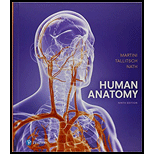
Human Anatomy (9th Edition)
9th Edition
ISBN: 9780134320762
Author: Frederic H. Martini, Robert B. Tallitsch, Judi L. Nath
Publisher: PEARSON
expand_more
expand_more
format_list_bulleted
Concept explainers
Question
Chapter 16, Problem 7RC
Summary Introduction
To review:
The area of the brain, which might be affected by a lesion or damaged in a person, with poor emotional control and memory loss.
Introduction:
In humans, the emotions, behavior, and thoughts are regulated by the brain’s limbic system. The limbic system (paleomammalian cortex) is present on either side of the thalamus and beneath the cerebrum. It contains nuclei and tracts along the border in between cerebrum and diencephalon.
Expert Solution & Answer
Want to see the full answer?
Check out a sample textbook solution
Students have asked these similar questions
Why is dementia progressive and irreversible?
Which of the following is NOT a symptom commonly shared between Alzheimer’s dementia and Lewy body dementia?
a-Hallucination
b-Decline in the ability to perform routine tasks
c-Loss of language skills
d-Gradual memory loss
Which type of brain wave indicates emotional stress?
Knowledge Booster
Learn more about
Need a deep-dive on the concept behind this application? Look no further. Learn more about this topic, biology and related others by exploring similar questions and additional content below.Similar questions
- Describe how a seizure develops in the brain tissue.arrow_forwardDefine the following concepts: Delusion: Hallucination:arrow_forwardA client experiencing hallucinations tells a nurse, "The voices are telling me I'm no good." The client asks whether the nurse hears the voices. Which is the nurse's MOST appropriate response? Question 7 options: a) "It is the voice of your conscience, which only you can control." b) "Those voices are coming from within you; only you can hear them." c) "Hearing the voices are a symptom of your illness; don't pay attention to them." d) "No, I do not hear the voices, but I believe you can hear them."arrow_forward
- What are the common manifestations of types of traumatic brain injury (focal, polar, diffuse) and hemorrhage (epidural, subdural, subarachnoid)?arrow_forwardAre there better techniques, methods, or even dietary supplements that could assist with improving brain function and memoryarrow_forwardwhich of the following would be expected following damage to the parietal lobe ? a) issues with memory b) issues with spatial processing c) issues with movement d) issues with visionarrow_forward
- A patient is admitted with a suspected cerebrovascular accident (CVA). Which assessment finding is most indicative of a left hemispheric stroke? a) Right-sided neglect b) Aphasia c) Right-sided weakness d) Impaired short-term memoryarrow_forwardDescribe the four clusters of symptoms considered in the diagnosis of PTSD. What is the major difference between PTSD and acute stress disorder (ASD)?arrow_forwardWhat is Alzheimer’s Disease (AD)? Describe 3 ADLs and how they are impacted as a resident’s AD gets worse (progresses). Describe types of therapies that can increase the quality of life for a person diagnosed with Alzheimer's.arrow_forward
arrow_back_ios
SEE MORE QUESTIONS
arrow_forward_ios
Recommended textbooks for you
